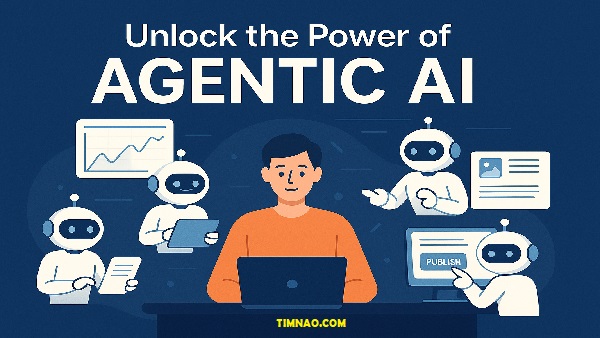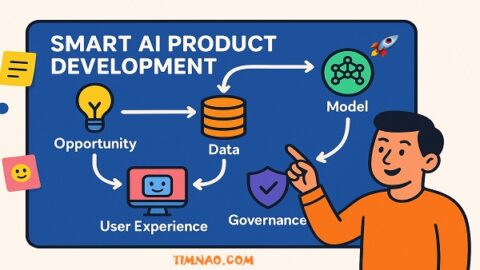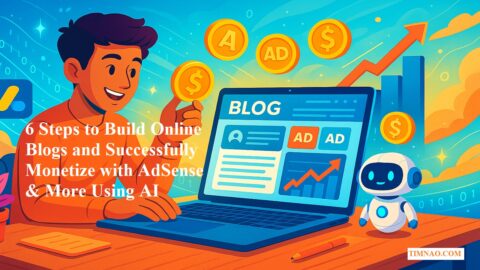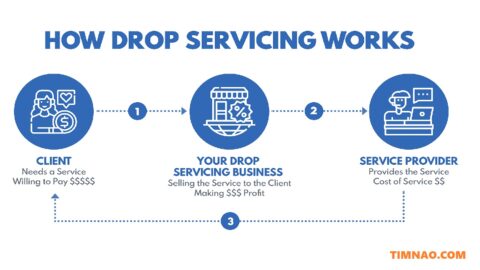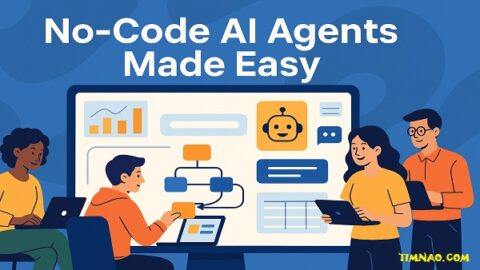Unlock Incredible Success with Agentic AI 🚀: Why Smart Systems Beat Burnout
Agentic AI is changing the game — not just for tech experts, but for everyday creators, freelancers, entrepreneurs, and small businesses who want to get more done without burning out.
Forget the hype. This isn’t about futuristic robots or far-off innovation. It’s about real, working systems you can start using today — systems that automate your tasks, scale your productivity, and even help you build an online business in 24 hours or less. And the best part? You don’t need to know how to code.
Whether you’re tired of repetitive tasks, exploring new income streams, or simply want to do more with less, this beginner-friendly guide will show you how to build your own AI-powered digital dream team — using the latest in multi-agent systems, AI automation tools, and zero-code platforms.
Ready to future-proof your productivity and unlock your full potential?
👇 Let’s dive in.
📚 Table of Contents
- 🚀 The Rise of Agentic AI: Your Digital Dream Team
- 🧠 AI Agents vs. Traditional Automation: What’s the Difference?
- ⚙️ Behind the Curtain: How Multi-Agent Systems Actually Work
- 🛠️ Build Smarter, Not Harder: The Role of MCP & A2A Protocols
- 📈 Real-World Use Cases You Can Start Using Today
- 🧩 No Code? No Problem: Beginner-Friendly Paths to Start Now
- 💼 Build Your AI-Powered Business in 24 Hours
- 🔁 The New 24/7 Workflow: Zero Burnout, Maximum Output
- 🧬 Your Personalized AI Ecosystem: From Tools to Team
- 🏁 Final Thoughts: The Road to Agentic Superpower
- ❓ FAQs: Beginner Questions About Agentic AI Answered
🚀 The Rise of Agentic AI: Your Digital Dream Team
In 2025, we’ve entered a new era — one where artificial intelligence is no longer just a fancy chatbot or data tool. Instead, it’s becoming a digital dream team that works beside you, not just for you.
This is the world of agentic AI — intelligent, autonomous software agents that act independently to complete tasks, make decisions, and work collaboratively as a team. These agents don’t sit idle waiting for you to give orders. They understand your goals, organize themselves, and proactively get things done.
So what does that really mean?
Imagine logging off at night and waking up to find your AI team has:
- Written a blog post tailored to your audience,
- Designed graphics for it,
- Optimized it for SEO,
- Scheduled it for posting — all while you slept.
This isn’t just automation. It’s AI-powered delegation.
And you don’t need to be a developer or a tech CEO to benefit. Whether you’re a solo content creator, a busy entrepreneur, or a startup founder, these multi-agent systems give you the edge of having a 10-person team — without the payroll.
Agentic AI is built to understand context, react in real time, and collaborate with other digital agents or tools. This transforms how we manage tasks, run businesses, and even live our personal lives.
Think of it this way: where traditional tools are like machines waiting for instructions, agentic AI is like having skilled assistants who understand the bigger picture and execute without micromanagement.
With tools like Claude, LangChain, and new protocols like MCP (Model Context Protocol), it’s now possible to create your own AI teams that:
- Read and summarize documents,
- Answer emails,
- Plan projects,
- Write code,
- And take action autonomously.
We’re not talking about automating a to-do list. We’re talking about building a self-operating system — a digital dream team that runs your life and business while you focus on creativity and strategy.
🧠 AI Agents vs. Traditional Automation: What’s the Difference?
Let’s clear up the confusion: agentic AI is not the same as traditional automation. While both aim to save time and boost productivity, their approach — and capabilities — are completely different.
🧾 Traditional Automation: The Rule-Follower
Think about tools like Zapier, IFTTT, or rigid software workflows. They’re powerful, but they operate like assembly lines — executing pre-defined actions when a trigger occurs.
Example:
- New email arrives → Save attachment to Google Drive → Send Slack message.
That’s helpful, but it only works within tight parameters. If anything changes or goes outside the preset rules? The system fails.
🧠 AI Agents: The Decision-Makers
Now imagine an AI agent trained to understand your goals. It doesn’t just follow steps; it makes smart decisions.
For example, a Customer Support Agent might:
- Identify a complaint from tone and keywords,
- Search your database for the order info,
- Proactively offer a refund or credit,
- Draft a kind, empathetic response — and send it.
You never told it what to do line-by-line. It understood the situation, decided on the best course of action, and executed it. That’s agentic intelligence.
| Feature | Traditional Automation | AI Agents (Agentic AI) |
|---|---|---|
| Works with rigid triggers | ✅ Yes | ❌ Rarely Needed |
| Handles unstructured tasks | ❌ Limited | ✅ Fully Capable |
| Adapts to changing situations | ❌ No | ✅ Yes |
| Makes autonomous decisions | ❌ No | ✅ Yes |
| Collaborates with other agents | ❌ Not built-in | ✅ Core Functionality |
| Learns and improves | ❌ Static | ✅ Continuously evolves |
The difference is initiative. Where old-school automation waits for your cue, AI agents take initiative. They act like intelligent teammates rather than mindless machines.
🧠 LLMs vs. Agents: A Common Misunderstanding
Another important distinction: AI agents are not just fancy chatbots like ChatGPT or Gemini. Those tools are LLMs (Large Language Models) — great at generating text, translating, or brainstorming ideas. But they’re reactive.
An AI agent, on the other hand, can:
- Access external tools (like a weather API or email platform),
- Plan a task from end to end,
- Evaluate its own results,
- Work with other agents or even humans.
In short:
- LLMs generate answers.
- Agents execute actions.
This makes AI agents the next step in productivity — turning intelligence into impactful results without constant human input.
⚙️ Behind the Curtain: How Multi-Agent Systems Actually Work
Let’s lift the hood on what makes multi-agent systems tick — and why they’re quickly becoming the most powerful force in AI-driven productivity.
A multi-agent system (MAS) is a network of specialized AI agents that work together toward a shared goal. Each agent is designed to excel at one thing — writing, researching, planning, coding, designing, etc. — and they all communicate through a shared digital brain called a context layer.
Think of it like a team of superheroes 🦸♂️
- VisionAgent finds visual inspiration and suggests design ideas.
- ResearchAgent gathers data and relevant facts.
- WriterAgent turns that info into articles, ads, or scripts.
- EditorAgent reviews everything for tone, grammar, and SEO.
- PublisherAgent posts it directly to your blog or CMS.
Each agent has its own “superpower” but works in harmony with the others. The result? A seamless, end-to-end system that can complete complex tasks with little or no human involvement.
Instead of one all-powerful AI, you have a network of focused, intelligent performers — each optimized for its specific task. And they don’t get tired, distracted, or overwhelmed. Ever.
A Real-World Example: Creating a Blog Post with Agents
Let’s say you want to create a new blog article titled “How AI Is Changing Freelancing.”
Here’s how a multi-agent system would do it:
- TopicAgent finds trending topics using Google Search tools.
- OutlineAgent drafts a structure with subheadings.
- ContentWriterAgent writes each section with research-backed points.
- EditorAgent polishes it for clarity and SEO.
- UploaderAgent posts it to your WordPress or Ghost CMS.
And the entire process can run automatically — triggered by a single user prompt or scheduled event.
These agents communicate via shared memory, pass results to one another, and adapt based on real-time feedback. No need to prompt each one manually. Once they understand your goal, they run the show.
Why It’s Better Than “All-in-One” AI
Some people wonder: why not just use a single smart AI model to do it all?
Here’s why specialization beats generalization:
- You can assign different models to different agents (e.g., GPT-4 for writing, Claude for summarizing).
- You avoid bottlenecks and delays by running agents in parallel.
- You reduce risk — if one agent fails, the others keep working.
- You get better results — each agent is optimized for its exact task.
It’s like building a Formula 1 team: you don’t want one person doing everything. You want experts in every role, working together in perfect sync.
And that’s exactly what multi-agent systems deliver.
🛠️ Build Smarter, Not Harder: The Role of MCP & A2A Protocols
So how do these agents talk to each other, share tools, and run as a unified team?
That’s where MCP (Model Context Protocol) and A2A (Agent-to-Agent Protocol) come in — the unsung heroes behind the scenes that power agentic AI automation tools.
🔌 MCP: The Universal Language of AI Agents
Think of MCP as the USB-C of the AI world — a standardized connector that lets different agents access tools, share data, and run workflows, regardless of their model or provider.
Before MCP, integrating tools with AI was messy. You had to:
- Write custom code for each API,
- Manually define tool inputs and outputs,
- Rebuild workflows every time you switched models.
Now? With MCP, it’s plug-and-play.
Here’s what MCP enables:
- 🔍 Tool Access: Agents can read PDFs, fetch URLs, query databases, or generate images.
- 📡 Real-Time Data: Agents can interact with APIs, CRM platforms, or live web sources.
- 🧠 Memory Sharing: Agents can access shared context so they know what’s already been done.
- ⚙️ Modular Development: Build once, reuse everywhere. Swap out tools or models instantly.
For example, a Content Generator Agent could call on:
- A “read-PDF” tool to extract content,
- A “summarize” tool to digest it,
- And a “write” tool to create something new — all via MCP.
No hardcoding required.
This creates reusable toolkits that any AI agent can tap into. And it means you can grow your system as your needs evolve — add more tools, smarter agents, and custom workflows without starting from scratch.
🤖 A2A: When Agents Talk to Each Other
Next up is A2A, short for Agent-to-Agent protocol — pioneered by Google and others to help agents interact as if they were colleagues on a team.
Where MCP handles tools, A2A handles conversations.
Imagine this scenario:
- A ProjectManagerAgent tells the WriterAgent to create an outline.
- The WriterAgent finishes and pings the EditorAgent for review.
- The EditorAgent flags a missing stat and notifies the ResearchAgent to find one.
- The ResearchAgent pulls data from a live web search and sends it back.
This is not a fantasy — it’s a fully autonomous agent conversation, managed by protocols like A2A.
What’s amazing is that these interactions:
- Can be goal-based (not just task-based),
- Don’t require hardcoded paths,
- And can scale to dozens (even hundreds) of agents.
Each agent acts independently, yet follows the same context universe — thanks to MCP and A2A working together behind the scenes.
✅ Why This Matters for You
Whether you’re building a side hustle, launching a SaaS tool, or streamlining daily tasks, these protocols are what make modern AI automation tools so powerful — and beginner-accessible.
You don’t need to code your own chatbot from scratch.
You can simply:
- Deploy prebuilt MCP servers (e.g., for reading files, fetching APIs, sending emails),
- Set up workflows using tools like LangChain or CrewAI,
- Let agents talk via A2A,
- And focus on the results.
In other words: build smarter, not harder.
With the right architecture — and the right protocols — you can create an agentic ecosystem that runs your personal brand, content factory, or microbusiness 24/7, with little to no manual work.
📈 Real-World Use Cases You Can Start Using Today
The power of agentic AI isn’t just theoretical — it’s already transforming businesses, boosting solo creators, and simplifying daily life. If you’re wondering how this tech fits into your world, here are some real-world use cases to inspire your next move.
1. 🎯 Content Creation: From Blank Page to Published Post
For creators, bloggers, and marketers, agentic AI removes the most time-consuming parts of content production.
Here’s a typical agent workflow:
- TopicAgent pulls ideas based on trending search terms.
- OutlineAgent organizes structure and headings.
- WriterAgent generates each section with researched content.
- SEOAgent optimizes keywords, meta tags, and readability.
- ImageAgent creates AI-generated visuals.
- SchedulerAgent queues content for social media or CMS.
Tools like Claude for Desktop, LangChain, or Notion AI already enable much of this — and with multi-agent systems, you can do it all in one flow.
💡 Even YouTubers and podcasters are automating transcripts, summaries, scripts, thumbnails, and SEO with agents.
2. 🛒 E-commerce Automation: Run a Lean Store with Zero Employees
Running an online store? You don’t need a big team anymore.
With AI automation tools, a solo founder can:
- Use ProductResearchAgent to find trending niches via tools like Exploding Topics.
- Deploy a ListingAgent to write persuasive, optimized product descriptions.
- Launch a CustomerSupportAgent to handle FAQs or complaints using conversational AI.
- Automate restocking, order tracking, and even supplier outreach through InventoryAgents.
Want to sell on Etsy, Amazon, or Shopify? Agentic systems can integrate with platforms like Shopify Flow or Make.com to fully automate your product lifecycle.
3. 🧠 Personal Productivity: Your New Digital Executive Assistant
Ever wished you had someone to:
- Book meetings,
- Track your expenses,
- Organize your tasks,
- Summarize articles,
- Send follow-ups?
That’s what personal AI agents can now do — and they’re already being used in tools like xAI’s Grok, Rewind, and Opal.
Picture a SmartDayAgent that checks your calendar every morning, suggests your priorities, and rearranges your day to match your goals — all on autopilot.
4. 💼 B2B & Agencies: Deliver Client Work at Scale
Agencies can productize agentic systems into client-facing services, such as:
- Full blog writing and publishing pipelines.
- Monthly newsletter automation.
- Keyword research + content outline generation.
- AI-powered lead magnets.
- Custom AI dashboards and chatbots.
With multi-agent systems, agencies can reduce costs, scale output, and create consistent results — all while keeping human oversight for quality.
And yes — this can all be turned into a productized service or micro-SaaS, which we’ll cover in the next part.
5. 🏥 Healthcare & Elder Care: AI with Empathy
Startups like Hippocratic AI are already creating healthcare-focused agents like “Sarah” and “Judy” — digital companions who:
- Remind patients of medication schedules,
- Help with pre-op preparation,
- Provide emotional support during recovery.
These agents are trained not just in medical tasks but also empathetic language, helping people feel cared for — even when no human is available.
6. 🧾 Admin Tasks: Goodbye to Busywork
AI agents can now:
- Monitor your inbox for important messages,
- Organize and tag files in your drive,
- Convert PDFs to summaries or spreadsheets,
- Generate invoices and track payments,
- Write weekly reports and slides from data.
If it’s repetitive and rules-based, there’s probably an AI agent for it — or you can build one in minutes.
🧩 No Code? No Problem: Beginner-Friendly Paths to Start Now
Feeling overwhelmed by all the tech talk? Don’t worry — you don’t need to code or understand APIs to start using agentic AI systems today.
Thanks to no-code tools and beginner frameworks, you can launch powerful workflows with just a few clicks.
🔧 Option 1: Use Prebuilt Agent Systems (Plug-and-Play)
Several platforms now offer ready-to-use agent systems you can install, customize, and start using instantly.
Here are a few beginner-friendly ones:
- CrewAI – A visual builder for multi-agent workflows (writing, planning, customer service).
- Flowise AI – Build LangChain-powered flows using drag-and-drop blocks.
- Superagent – Create and deploy AI agents on the cloud with zero backend setup.
- Claude for Desktop – Add tools (MCP servers) to Claude’s UI for file access, web scraping, weather queries, etc.
Most of these platforms allow you to:
- Assign roles to agents,
- Define workflows visually,
- Access tool integrations (email, PDFs, Notion, etc.),
- And run tasks autonomously.
📦 Option 2: Use Templates from Marketplaces
You can also explore free or paid templates from:
- PromptBase – For prompt-based workflows.
- Gumroad – Search for “AI agents,” “LangChain templates,” or “agentic automation.”
- Notion AI Templates – For business systems with built-in automation.
Many creators have packaged their pre-built agent stacks — just plug in your goals, and they’ll run your business workflows for you.
⚙️ Option 3: Automate with n8n (Zero Code, Full Power)
n8n.io is a visual automation platform like Zapier — but designed for developers and power users. It lets you:
- Build agent-triggered workflows using Claude, GPT, or other LLMs.
- Connect with APIs like Stripe, Slack, Airtable, or Google Sheets.
- Schedule tasks (daily, weekly, after an event).
- Monitor and optimize your automation with logs and triggers.
Even beginners can follow tutorials and templates to get started. Want to create a “Zero Click Newsletter System”? You can do that in n8n — with no coding at all.
🌐 Bonus: Mix and Match Platforms
The beauty of agentic AI systems is modularity.
- Want Claude to talk to Notion? Use an MCP Notion server.
- Want to scrape the web with Brave Search? Add the Brave MCP tool.
- Want to automate file handling on your PC? Enable filesystem agents.
Platforms like Pulsemcp and modelcontextprotocol.io offer open-source toolkits to help you explore what’s possible — without having to write a single line of code.
You don’t need to be a developer to benefit from multi-agent systems.
You just need curiosity, a clear goal, and a willingness to test what’s already been built.
The no-code revolution isn’t just for websites or landing pages anymore — now it powers AI teams, fully equipped to work for you.
💼 Build Your AI-Powered Business in 24 Hours
Starting a business used to take months — planning, hiring, building websites, finding clients, and managing endless to-do lists. But with agentic AI and modern AI automation tools, it’s now possible to launch a fully functional digital business in just 24 hours.
And yes — even if you’re starting from scratch.
🧩 Step 1: Choose Your Value Offer (No Products Needed)
Start by asking: “What can I help people achieve using AI?”
You don’t need to invent something groundbreaking. You just need to offer a repeatable outcome powered by agentic systems. For example:
- “I’ll write and publish your weekly blog posts using AI agents.”
- “I’ll build a hands-free newsletter that runs on autopilot.”
- “I’ll turn your PDF reports into SEO-optimized blog content.”
- “I’ll create an AI chatbot that answers customer FAQs 24/7.”
Whether you’re offering content, automation, or consulting, the key is: pick one outcome you can deliver efficiently using your agent team.
🛠️ Step 2: Build a Simple Multi-Agent Stack
You don’t need to build a complex system. Use tools like CrewAI or Flowise to create a basic multi-agent pipeline that completes your offer from start to finish.
Let’s say you offer blog writing:
- TopicAgent finds trending ideas using Google Trends.
- WriterAgent generates the first draft.
- EditorAgent reviews tone and fixes grammar.
- SEOAgent ensures keywords, meta, and structure are optimized.
- PublisherAgent uploads to WordPress or Ghost.
This stack can run fully or semi-autonomously with your light oversight.
Bonus: many platforms let you reuse and remix agent flows, so you can apply the same system to multiple clients.
💸 Step 3: Productize & Launch
Create a simple landing page or Gumroad offer that explains:
- What you deliver
- How fast you deliver it
- What problems you solve
- What tools you use (position yourself as “AI-powered”)
You don’t need to build a huge website. Just clearly describe your AI-powered solution, and use platforms like:
- Carrd or Framer for a one-page site
- Gumroad or Lemon Squeezy for easy checkout
- Tally or Typeform for client onboarding
Promote your new business via:
- Reddit communities (e.g. r/Entrepreneur, r/SaaS, r/ChatGPT)
- Indie Hacker platforms
- Twitter/X and LinkedIn with daily progress updates
Within 24 hours, you can have:
✅ An offer
✅ A functioning agent system
✅ A landing page
✅ A way to collect payments
From there, it’s all about testing and refining — with AI agents doing the heavy lifting.
🔁 The New 24/7 Workflow: Zero Burnout, Maximum Output
Now let’s talk about the real magic of agentic AI: once your system is up and running, it works around the clock — without complaints, coffee breaks, or burnout.
🚀 The 24/7 AI Workflow
Here’s how a solo founder can scale output without scaling stress:
- 🕓 4AM — TopicAgent scans the web for content trends.
- 🕔 5AM — ResearchAgent pulls data and links.
- 🕕 6AM — WriterAgent drafts blog posts or ad copy.
- 🕖 7AM — SEOAgent optimizes for keywords.
- 🕗 8AM — PublisherAgent posts to your CMS and schedules shares.
- 🕘 9AM — You check performance metrics over coffee ☕ and plan the next experiment.
Instead of doing everything yourself, you become the strategic overseer — managing AI-powered systems that perform repeatable tasks consistently and faster than any human.
🧘♂️ Designed for Flow, Not Burnout
Most people chase productivity through hustle. But with multi-agent systems, you chase clarity and design instead.
You:
- Build workflows once
- Let AI agents operate them
- Check in as needed
- Free your mind for vision, creativity, and rest
In essence, you go from doing the work to designing the system that does the work.
It’s the difference between being the chef and building the restaurant.
🔄 How Agentic AI Multiplies Your Time
Here’s what happens when you go agentic:
| Task | Human Time | Agentic Time |
|---|---|---|
| Blog post writing | 4 hours | 15 minutes |
| Researching trends | 1 hour | 3 minutes |
| Sending email sequences | 45 minutes | 2 minutes |
| Responding to customer inquiries | 1-2 hours | Instantly |
The average agent-powered workflow replaces 8–10 hours of manual effort per day. That’s not just efficiency — that’s time freedom.
You can reinvest that saved time to:
- Grow your business
- Launch new offers
- Spend time with family
- Or just rest, recharge, and live
🧠 Burnout Is a System Problem — Solve It with Agentic Design
If you’re feeling overwhelmed, burnt out, or buried under to-dos — it’s not a motivation issue. It’s a system issue.
And agentic AI gives you the tools to fix the system by:
- Delegating complex workflows to autonomous agents,
- Building repeatable systems with minimal input,
- Creating self-sustaining operations that work while you rest.
You can build a machine that builds value — and it runs quietly, reliably, and predictably.
And it never burns out.
🧬 Your Personalized AI Ecosystem: From Tools to Team
The beauty of agentic AI is that it’s not one-size-fits-all. You get to design an AI-powered ecosystem tailored to your specific goals, tools, and work style — just like assembling your dream team.
Think of it like building a digital agency that runs itself — with agents acting as your writers, researchers, editors, assistants, developers, marketers, or even sales reps.
🔧 Step 1: Pick Your Foundation Tools
Start with the tools you’re already using or feel comfortable adopting. Then, build your agent stack around them.
Popular tools to anchor your ecosystem:
- Notion – For project management, content hubs, and documentation.
- Google Sheets – For data tracking, automation triggers, and agent updates.
- Slack/Discord – For agent-human communication.
- WordPress / Ghost – For publishing and content management.
- Email & Calendars – For outreach, scheduling, and reminders.
With MCP tool servers, agents can directly access and control these apps — like digital teammates who know your workspace inside-out.
🧠 Step 2: Assign Agent Roles (Your Dream Team)
Design your AI team like a real-world org chart. Each agent gets a title, a task, and a goal.
Example setup:
- CEOAgent: Oversees operations and priorities.
- ResearchAgent: Gathers data from the web.
- StrategyAgent: Identifies trends and growth opportunities.
- CopyAgent: Writes landing pages, emails, or blog posts.
- DesignAgent: Generates visuals using Midjourney or DALL·E.
- SEOAgent: Optimizes everything for discoverability.
- SupportAgent: Answers customer questions and manages feedback.
Each agent plugs into your tools, uses shared memory (context), and performs specific workflows based on your needs.
🔁 Step 3: Automate Communication & Handoff
Using A2A (Agent-to-Agent) protocols, your agents can “talk” to each other — handing off tasks, flagging issues, and refining results.
For example:
- The CopyAgent finishes an article → triggers SEOAgent to optimize it → notifies DesignAgent to create a featured image → signals PublisherAgent to post it online.
All you do? Review the final product — or skip review entirely once you’re confident in your system.
This isn’t just automation. It’s orchestration.
And as you grow, you can add new agents, upgrade existing ones (swap models), or train them with your style, tone, and preferences.
You’re not using a tool. You’re building a workforce — customized, consistent, and infinitely scalable.
🏁 Final Thoughts: The Road to Agentic Superpower
Agentic AI isn’t a trend — it’s the future of work.
The old way of doing things — juggling dozens of apps, burning hours on repetitive tasks, and drowning in to-dos — is becoming obsolete. In its place is a smarter, leaner, faster approach to personal productivity and digital business.
With multi-agent systems and AI automation tools, you can:
- Build systems that run while you sleep.
- Launch businesses in hours, not months.
- Multiply your output without multiplying your workload.
- Replace burnout with balance — without sacrificing success.
It’s not about being replaced by AI — it’s about being amplified by it.
Whether you’re a solopreneur, a creative, a small business owner, or someone exploring your next digital move — agentic AI gives you the power to turn vision into reality, faster and smarter than ever.
And the best part? You can start today.
❓ FAQs: Beginner Questions About Agentic AI Answered
To wrap things up, here are some common questions beginners ask about agentic systems:
🔍 What’s the difference between ChatGPT and an AI Agent?
ChatGPT is a language model that responds to prompts. It’s reactive.
An AI agent is proactive — it can plan, act, and use external tools without waiting for a command.
Agents can:
- Use APIs,
- Read documents,
- Automate workflows,
- Talk to other agents.
ChatGPT is powerful. Agents are self-operating systems.
🤖 Do I need to know how to code?
No. Thanks to no-code tools like CrewAI, Flowise, and Superagent, anyone can build multi-agent workflows visually.
You can use drag-and-drop builders, templates, and tutorials to launch powerful AI systems — even as a beginner.
🛠️ What tools or platforms should I start with?
Start with these:
- Claude or GPT-4 – As your core language models
- CrewAI / LangChain – To organize multi-agent flows
- MCP Tool Servers – To give agents access to tools (PDFs, search, email, etc.)
- Notion / Google Sheets – For project tracking and context sharing
You can expand as you go. Just start small, test a simple workflow, and grow it over time.
💼 What kind of businesses can I run with agents?
Popular ideas include:
- AI-powered content services
- Email marketing automation
- Lead gen systems
- SEO optimization offers
- Product description writing for eCommerce
- AI customer support services
You can also turn your multi-agent system into a SaaS or productized service.
🌍 Will AI take my job?
No — but it will replace people who don’t learn to use it.
Agentic AI is a tool. The most valuable people in 2025 and beyond will be those who:
- Understand what agents can do,
- Design smart workflows,
- Combine creativity + automation.
Use AI to enhance your value, not erase it.
🎯 What should I do right now?
Here’s a 3-step quick start:
- Pick a simple workflow you do often (e.g., writing, research, scheduling).
- Build a mini-agent system using a tool like CrewAI.
- Run it once, tweak it, and watch the results.
From there? Scale up.

